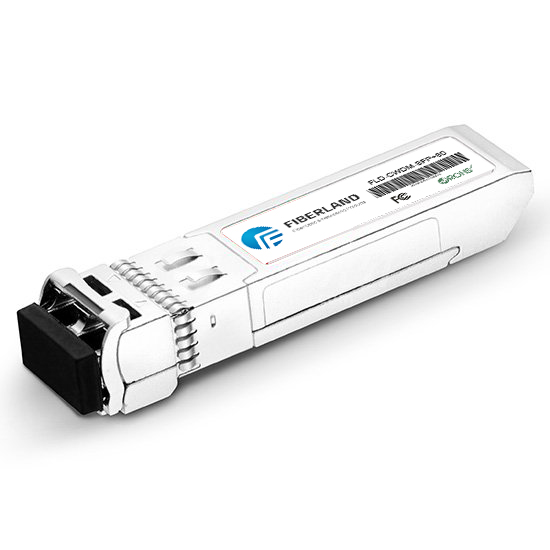Features of 1000Base-T Copper SFP Transceivers
2017-06-15
Copper transceiver is high performance, cost effective module compliant with the Gigabit Ethernet and 1000BASE-T standards as specified in IEEE 82. 3-22 and IEEE 82.3ab, which supporting 1Mbps data- rate up to 1 meters reach over unshielded twisted-pair CAT 5 cable. Copper SFPs enable system manufacturers to populate SFP ports with either copper or optical transceivers.

1000Base-T copper SFP is used for copper networks, which refers to GbE over copper, primarily Category 5, 5E, and, increasingly, Category 6 twisted-pair cable. Typical 1000Base-T SFP includes Cisco-GLC-T and SFP-GE-T, these SFP modules are used in Gigabit networks and they are fully compatible with 1000Base-T. SFP-GE-T is the copper SFP that are with extended working temperature and DOM support.
1000Base-T SFP copper transceiver is designed for single mode (SM) optical fiber. This transceiver is compliant with Gigabit Ethernet and 1000BASE-T standards as specified in IEEE802.3-2002 and IEEE 802.3ab for 1.25 Gigabit over unshielded twisted-pair category-5 cable. It operates on standard Category 5 unshielded twisted pair copper cabling of up to 100m length. This transceiver is also compliant with RoHS, SFP MSA, FCC 47 SFR Part 15, Class B and SONET/SDH recommendations for OC-48 specifications. It is widely used in serial telecom and datacom applications.
The 1000Base-T SFP copper module is compliant with Gigabit Ethernet and 1000BASE-T standards as specified in IEEE802.3-2002 and IEEE 802.3ab for 1.25 Gigabit over unshielded twisted-pair category-5 cable. It offers 1000Mbps full duplex data-links with 5-level Pulse Amplitude Modulation (PAM) signals. This transceiver is also compliant with RoHS, SFP MSA, FCC 47 SFR Part 15, Class B and SONET/SDH recommendations for OC-48 specifications. It is widely used in serial telecom and datacom applications. Cisco 1000BASE-T SFP module supports 10/100/1000 auto-negotiations and Auto MDI/MDIX.
SFP+ module,SFP+ transceiver,bidi sfp,XFP module,XFP transceiver Which is good? First choice FIBERLAND!Thanks for your concern, to learn more about FIBERLAND, please enter FIBERLAND website: http://www.fiberlandtec.com/

1000Base-T copper SFP is used for copper networks, which refers to GbE over copper, primarily Category 5, 5E, and, increasingly, Category 6 twisted-pair cable. Typical 1000Base-T SFP includes Cisco-GLC-T and SFP-GE-T, these SFP modules are used in Gigabit networks and they are fully compatible with 1000Base-T. SFP-GE-T is the copper SFP that are with extended working temperature and DOM support.
1000Base-T SFP copper transceiver is designed for single mode (SM) optical fiber. This transceiver is compliant with Gigabit Ethernet and 1000BASE-T standards as specified in IEEE802.3-2002 and IEEE 802.3ab for 1.25 Gigabit over unshielded twisted-pair category-5 cable. It operates on standard Category 5 unshielded twisted pair copper cabling of up to 100m length. This transceiver is also compliant with RoHS, SFP MSA, FCC 47 SFR Part 15, Class B and SONET/SDH recommendations for OC-48 specifications. It is widely used in serial telecom and datacom applications.
The 1000Base-T SFP copper module is compliant with Gigabit Ethernet and 1000BASE-T standards as specified in IEEE802.3-2002 and IEEE 802.3ab for 1.25 Gigabit over unshielded twisted-pair category-5 cable. It offers 1000Mbps full duplex data-links with 5-level Pulse Amplitude Modulation (PAM) signals. This transceiver is also compliant with RoHS, SFP MSA, FCC 47 SFR Part 15, Class B and SONET/SDH recommendations for OC-48 specifications. It is widely used in serial telecom and datacom applications. Cisco 1000BASE-T SFP module supports 10/100/1000 auto-negotiations and Auto MDI/MDIX.
SFP+ module,SFP+ transceiver,bidi sfp,XFP module,XFP transceiver Which is good? First choice FIBERLAND!Thanks for your concern, to learn more about FIBERLAND, please enter FIBERLAND website: http://www.fiberlandtec.com/
RECENT BLOG POST
-
012019-10With the continuous development of 5G communication technology, 100G modules are gradually becoming popular. We know that there are many kinds of packages for 100G optical modules. From 2000 to now, the optical module package types have been rapidly developed. Its main package types are: GBIC, SFP, XENPAK, SNAP12, X2, XFP, SFP+, QSFP/QSFP+, CFP, CXP. In the fast-developing network era, some 100G optical modules avoid the risk of being eliminated, and upgraded and revised with the wave of the Internet, such as 100G CFP optical modules.
-
012019-101. What is the CWDM SFP? The CWDM optical module is an optical module using CWDM technology to implement the connection between the existing network device and the CWDM multiplexer/demultiplexer. When used with a CWDM multiplexer/demultiplexer, CWDM optical modules can increase network capacity by transmitting multiple data channels with separate optical wavelengths (1270 nm to 1610 nm) on the same single fiber.
-
012019-10AOC is the abbreviation of Active Optical Cables, which is called Active Optical Cables in Chinese. AOC active optical is to encapsulate two optical modules and cable together. Because the medium of transmission in the middle is optical cable, AOC optical module, which contains laser devices, has a higher price for DAC. However, its optical aperture is not exposed, it has high reliability, and its working distance can be customized for a long distance of less than 100 meters.
-
012019-10Dense Wavelength Division Multiplexing (DWDM) technology is capable of transmitting data in an optical fiber using bit wavelength parallel transmission or string line transmission using the wavelength of the laser.It is widely used in different fields of communication networks, including long-distance backbone networks, metropolitan area networks (MANs), residential access networks, and local area networks (LANs).The DWDM optical module is the optical module that uses this technology, so the DWDM optical module has high bandwidth and long-distance transmission characteristics.












